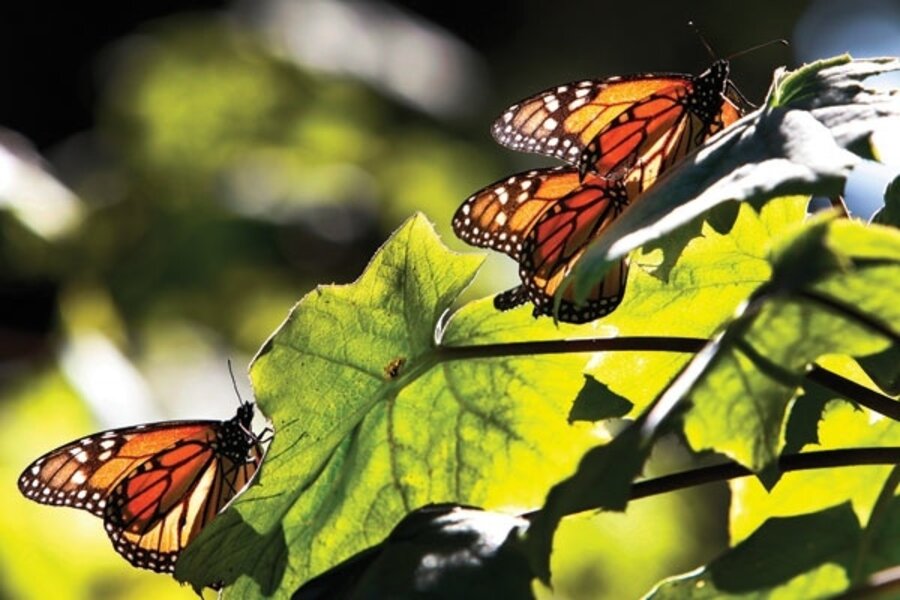Butterflies versus beetles
Loading...
| Sierra Chincua, Mexico
The butterflies flitting in the sky above seem ablaze, as sunlight filters down into the Sierra Chincua forest in Mexico’s Monarch Butterfly Biosphere Reserve. Millions of the orange-and-black insects are just arriving, as part of their annual 2,800-mile journey from Canada and the United States.
But this year, because of the worst drought in nearly 70 years, an infestation of bark beetles has hit this 138,000-acre reserve, where tourists from around the world come to view part of a migration pattern considered one of the globe’s most extraordinary.
Authorities have already identified more than 7,500 beetle-infested fir trees – three times the normal amount in any given year – and have raced to cut them down. “We can expect to find more infected trees,” says Rosendo Caro, director of the reserve.
The bark beetle has always been present in the forest, but because of drought, the volume of resin that acts as a natural defense is much lower than usual. Beetles that usually are repelled by a flood of resin when attempting to enter trees have instead been able to burrow into them, sapping the trees of crucial nutrients.
The needles of affected trees turn yellow and red. In some cases, authorities mark the tree and wait to see if the infestation ceases on its own, but most must be cut down so the beetles do not reproduce inside and spread to other trees.
About 173 acres of the 32,000 acres in the reserve’s nucleus have been infected so far this year. Without trees to house them, the butterflies are threatened by cold winter air and rains.
Bark beetle damage in forests isn’t confined to Mexico. Forests across North America have been devastated, mostly because of drought, says Jaime Villa Castillo, a forestry expert at Mexico’s National Forest Commission.
On a recent day, deep in the forest, groups of men practiced “sanitation logging” to help prevent the spread of the bark beetles. They cut down trees, buried the infected bark underground, and used cables to haul heavy logs onto trucks. The work is slow, with trees inspected one by one, and it will have to stop when the butterflies arrive to spend the winter huddling in large groups on branches that droop under their weight.
Some environmentalists have criticized sanitation logging. They say that insecticides are a better option, because they kill the beetles while allowing the trees to live.
But government officials say that the law does not permit the use of insecticides within the reserve. “The only way to do this is to cut the trees down,” says Mr. Villa Castillo, who visited the forest on a recent day to monitor the project.
The tree removal effort comes as the Mexican government has made major strides against illegal logging, long a problem here. In 2006, monitoring cameras were set up, and the area was patrolled better. As a result, only about 138 acres of the reserve were illegally logged last year, compared with 10 times that amount in 2006, says Javier Medina, who heads strategic projects at the National Commission for Natural Protected Areas.
But the issue is still sensitive. On trucks that transport logs out of the reserve, authorities have placed signs on bumpers alerting passersby to the sanitation logging project. Otherwise, “they think we are taking advantage,” says Mr. Medina. But he emphasizes that environmental officials authorize every tree that is felled.
Each November, tens of thousands of tourists begin arriving at the reserve, a UN World Heritage Site, to watch skies darken with butterflies that sometimes land on caps and shoulders. The butterflies stay in the reserve until spring, when they make the return journey to the US and Canada.
Mr. Caro says that because authorities caught the beetle infestation early enough (they began their work in July), he expects butterflies, and the tourist season this year, to be unaffected. But scientists say this is only the beginning of a problem that could take several years to tackle.
“We are worried,” says Elia Contreras Juárez, the leader of an ejido, or land owned by peasants who have lived here for decades and whose land comprises about 70 percent of the reserve’s land. They are the ones carrying out the project under the direction of the federal government. “We need our forests to be safe,” she says.
Caro says that the problem could be a wake-up call, propelling politicians to promote tourism opportunities that go beyond butterflies, possibly focusing on hiking and the cuisine of the region.
They could also highlight the important role that the forest plays in capturing water that supplies Mexico City, he suggests.
“The butterflies are not the most important thing in this forest,” he says.
Editor’s note: For more articles about the environment, see the Monitor’s main environment page, which offers information on many environment topics. Also, check out our Bright Green blog archive and our RSS feed.





